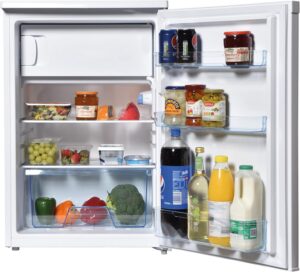Is a refrigerator the same as a fridge?
So, you’ve started pondering about the age-old debate in your kitchen: is a refrigerator the same as a fridge?
Well, let’s settle this once and for all! In a nutshell, the answer is yes – a refrigerator and a fridge are essentially the same thing.
While the terms may sound different, they both refer to a household appliance that is used to keep your food and drinks cool.
Now, let’s dive into the nitty-gritty details and explore the subtle differences, if any, between these two seemingly synonymous words.
History of the Terms Refrigerator and Fridge
Origins of the term ‘Refrigerator’
The term ‘refrigerator’ has its roots in the Latin word ‘refrigero’, which means ‘to cool’ or ‘chill’. The earliest use of the term can be traced back to the 17th century when it was used to describe any device or room used to keep items cool.
These early refrigerators were not as advanced as the ones we have today, but they laid the foundation for the modern refrigeration technology.
Genesis of the nickname ‘Fridge’
On the other hand, the nickname ‘fridge’ is a shorter and more casual term for refrigerator. Its origins can be traced back to the early 20th century when the word ‘refrigerator’ was considered too long and cumbersome to be used in everyday language.
People started using ‘fridge’ as a more convenient and colloquial way to refer to their cooling appliances. Over time, ‘fridge’ became a widely accepted and used term, even finding its place in dictionaries.
Technical Differences between Refrigerators and Fridges
Design variations
Refrigerators and fridges generally have the same purpose of keeping food and beverages cool or frozen, but there are some design variations between the two. Refrigerators are typically larger and more complex in design.
They often have separate compartments for fresh and frozen food, as well as additional features such as ice makers and water dispensers. On the other hand, fridges are smaller and simpler in design, usually consisting of only one cooling compartment.
Range of Sizes
Another difference between refrigerators and fridges is the range of sizes available.
Refrigerators come in various sizes, ranging from compact models suitable for small apartments to large, commercial-sized units used in restaurants or grocery stores.
Mini fridges, on the other hand, are smaller and often portable, making them ideal for dorm rooms, offices, or recreational vehicles where space is limited.
Feature sets
Refrigerators typically offer a wider range of features compared to fridges.
Many modern refrigerators come equipped with advanced features such as smart technology, touchscreens, and energy-saving options. Some models even have cameras inside that allow you to see the contents of your fridge remotely through a smartphone app. Fridges, meanwhile, tend to focus on basic cooling functionality without the added bells and whistles.
The Refrigeration Process
How refrigerators work
Refrigerators use a combination of compressors, evaporators, and condensers to cool and maintain the desired temperature inside the unit. The compressor compresses a refrigerant gas, increasing its pressure and temperature.
The hot, pressurized gas then flows into the condenser coils located on the back or bottom of the refrigerator, where it dissipates heat and becomes a high-pressure liquid.
Next, the high-pressure liquid refrigerant flows into the evaporator coils located inside the fridge compartment. As the liquid refrigerant expands, it absorbs heat from the surrounding air, cooling the fridge compartment. The refrigerant then returns to the compressor, and the cycle repeats.
How fridges work
Fridges, on the other hand, work on a simpler cooling principle called thermoelectric cooling.
This process involves the use of a thermoelectric module that utilizes the Peltier effect. When an electric current passes through the module, it creates a temperature difference between two sides of the module, resulting in one side becoming cooler and the other side warmer.
The cool side is then placed inside the fridge compartment to provide the necessary cooling effect.
It’s important to note that thermoelectric cooling is not as efficient as the refrigeration process used in refrigerators. Fridges usually operate at higher temperatures and are best suited for short-term storage of food and beverages.
Linguistic Nuances between Refrigerator and Fridge
Usage in different English-speaking regions
The use of the terms ‘refrigerator’ and ‘fridge’ can vary depending on the English-speaking region.
In North America, ‘fridge’ is the more commonly used term, while ‘refrigerator’ is also widely understood and accepted. In the United Kingdom and Australia, ‘fridge’ is the predominant term, and ‘refrigerator’ is less commonly used.
Colloquialisms and Pop Culture references
Both ‘refrigerator’ and ‘fridge’ have become part of colloquial language and are often used in various expressions and idioms. In pop culture, the fridge has been featured in movies, TV shows, and commercials, becoming an iconic symbol of food preservation and household convenience.
Phrases such as “cleaning out the fridge” or “stocking up the refrigerator” are commonly used to refer to the act of organizing or replenishing food supplies.
Energy Consumption
Energy efficiency of refrigerators
Refrigerators have made significant advancements in energy efficiency over the years. Modern refrigerators often come with Energy Star ratings, indicating their compliance with energy-saving standards.
These appliances are equipped with features such as improved insulation, LED lighting, and variable speed compressors, all aimed at reducing energy consumption.
Energy efficiency of fridges
Fridges, particularly mini fridges, generally consume less energy compared to full-sized refrigerators.
However, they may not have the same level of energy-saving features as larger models. It’s important to consider the Energy Star rating and specific energy consumption information when choosing a fridge, as some models may be more energy-efficient than others.
Types of Refrigerators and Fridges
Standard refrigerators
Standard refrigerators come in various configurations, including top-freezer, bottom-freezer, side-by-side, and French door styles. These refrigerators offer larger capacity and more storage options, making them suitable for families or households with higher food storage needs.
They often come with additional features such as ice and water dispensers, adjustable shelves, and temperature-controlled compartments.
Mini fridges
Mini fridges, also known as compact refrigerators, are smaller in size and offer a convenient solution for limited space situations. They are commonly used in dorm rooms, offices, or as a supplemental fridge in kitchens. Mini fridges typically have a single cooling compartment and may lack some of the advanced features found in standard refrigerators.
Side-by-side refrigerators
Side-by-side refrigerators feature two vertical doors, with the freezer compartment on one side and the fridge compartment on the other. These refrigerators offer a balanced design and easy access to both fresh and frozen food.
They often come equipped with ice and water dispensers, adjustable shelving, and ample storage options.
Cultural Significance
Evolution of refrigerators in the home
Refrigerators have become an integral part of modern households, revolutionizing the way we store and preserve food. In the past, people relied on iceboxes or other primitive cooling methods, making it challenging to keep perishable food fresh for extended periods.
The advent of the refrigerator made a significant impact on food safety, convenience, and overall quality of life.
Role of fridges in contemporary society
Fridges, particularly mini fridges, have found their place in various aspects of contemporary society.
They are commonly used in dormitories, offices, and recreational vehicles, catering to individual needs for convenience and portability.
Mini fridges have also become popular among students and young professionals living in small apartments, providing a compact solution for food and beverage storage.
Pros and Cons
Advantages and disadvantages of refrigerators
Refrigerators offer several advantages, including ample storage space, multiple compartments for organization, and a wide range of features.
They are ideal for large households or those who require extensive storage capacity. However, refrigerators can be costly, consume more energy, and may not be suitable for those with limited space.
Advantages and disadvantages of fridges
Fridges, particularly mini fridges, offer portability, energy efficiency, and compact size, making them suitable for small spaces or on-the-go usage.
They are often more affordable compared to standard refrigerators. However, their smaller size may limit storage capacity, and they may not offer the same advanced features as larger models.

Maintenance and Care
Caring for your refrigerator
To maintain the optimal performance of your refrigerator, it is important to keep it clean and well-organized.
Regularly cleaning the interior and exterior surfaces, checking and replacing the water filter (if applicable), and ensuring proper ventilation around the unit are crucial.
Additionally, paying attention to the temperature settings, avoiding overloading the fridge, and keeping the door seals in good condition will help prolong the lifespan of your refrigerator.
Maintaining a fridge properly
Maintaining a fridge involves similar care practices as a standard refrigerator.
Since mini fridges usually have smaller cooling compartments, it’s important to avoid overcrowding and ensure proper air circulation. Cleaning the interior, defrosting (if required), and periodically checking the power cord and electrical components are all important steps in keeping your fridge in good working condition.
Buying Guide for Refrigerators and Fridges
Factors to consider when buying a refrigerator
When purchasing a refrigerator, there are several factors to consider.
These include the size and capacity that suits your needs, the available space in your kitchen, energy efficiency ratings, and budget constraints. It’s also important to assess the features and functionalities you require, such as ice makers, water dispensers, or smart technology integration.
Considerations for purchasing a fridge
For those looking to buy a fridge, portability, size, and energy efficiency are key factors to consider.
Determine the appropriate size for your needs and ensure it fits in your desired location. Look for energy-saving options and check the estimated energy consumption to make an informed decision.
Assess the cooling capacity and any additional features you may require, such as reversible door hinges or adjustable temperature controls.
In conclusion, while the terms ‘refrigerator’ and ‘fridge’ are often used interchangeably, there are technical, linguistic, and cultural differences between the two.
Understanding these nuances can help you make an informed decision when choosing the right cooling appliance for your needs.
Whether you opt for a standard refrigerator or a mini fridge, taking into account factors like design, energy consumption, and maintenance requirements will ensure you find a reliable and efficient cooling solution.
So go ahead, keep your food fresh and cool with your preferred cooling appliance!


Is a refrigerator the same as a fridge?




